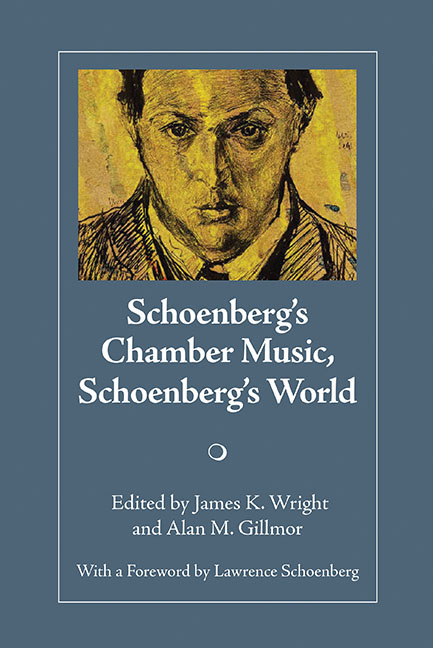Book contents
- Frontmatter
- Contents
- Foreword
- Preface
- HISTORICAL PERSPECTIVES
- The Young Arnold Schoenberg
- Schoenberg's String Quartet No. 1 in Dresden (1907): Programming the Unprogrammable, Performing the Unperformable
- A Bridge to a New Life: Waltzes in Schoenberg's Chamber Music
- The “Popular Effect” in Schoenberg's Serenade, Op. 24
- ANALYTICAL PERSPECTIVES
- OTTAWA SYMPOSIUM AND CHAMBER MUSIC FESTIVAL PHOTOS
- PERFORMANCE, RECEPTION, AND INTERNATIONAL INFLUENCE
A Bridge to a New Life: Waltzes in Schoenberg's Chamber Music
from HISTORICAL PERSPECTIVES
- Frontmatter
- Contents
- Foreword
- Preface
- HISTORICAL PERSPECTIVES
- The Young Arnold Schoenberg
- Schoenberg's String Quartet No. 1 in Dresden (1907): Programming the Unprogrammable, Performing the Unperformable
- A Bridge to a New Life: Waltzes in Schoenberg's Chamber Music
- The “Popular Effect” in Schoenberg's Serenade, Op. 24
- ANALYTICAL PERSPECTIVES
- OTTAWA SYMPOSIUM AND CHAMBER MUSIC FESTIVAL PHOTOS
- PERFORMANCE, RECEPTION, AND INTERNATIONAL INFLUENCE
Summary
As of 1905, Schoenberg's life, including his marriage to Mathilde Zemlinsky, was not particularly happy. The joyful early days of courtship behind him, the struggling composer was now a young husband and father, caught up in the financial worries and domestic strife that would plague his household off and on for much of the next two decades. Schoenberg documented the emotional foment of 1904-05 in the “secret program” of his String Quartet, Op. 7, which is of course now no longer a secret. The program describes a series of emotional ups and downs, hinting at the on-going conflict between, presumably, Schoenberg and Mathilde (“He and She” in the program) and Schoenberg's unsettled state. Early in the Quartet, after an intense and fractious opening, a waltz appears. Relative to the program, this waltz marks what Schoenberg identifies as a “transition,” a bridge passage, ultimately leading towards a temporary “struggle” and culminating in a section titled “Feeling new life.” For Schoenberg, waltzes are meaningful personal signifiers that are connected to intimate and intense feelings: they are abundant in his music, and serve a number of different functions. In the chamber music, it is especially clear that they have a particular significance, namely as gestures that mark moments of crisis and change, and that also often bridge these moments, metaphorically connecting past and present. Schoenberg once remarked to Egon Wellesz that “[m]y music is solely the representation of myself “; waltzes, it can be argued, are used by the composer as an important facet of this self-representation. They are used programmatically, autobiographically, and perhaps even psychologically; as commentary and reflection; and as a means to glance backwards, but also to move forward, and to forget. Closely tied to crisis and change, Schoenberg's chamber music waltzes are a key aspect of what Bryan Simms calls “the objectification of [Schoenberg's] private world.”
The exact nature of Schoenberg's marriage to Mathilde Zemlinsky may never be fully understood. Mathilde is mentioned only in passing in much of the secondary literature on Schoenberg. She was either marginal or marginalized, depending on the source consulted. She emerges briefly as a locus of crisis in 1908, the year of her affair with the young painter Richard Gerstl, a crisis concomitant with Schoenberg's decisive move to atonality.
- Type
- Chapter
- Information
- Schoenberg's Chamber Music, Schoenberg's World , pp. 25 - 36Publisher: Boydell & BrewerPrint publication year: 2009
- 1
- Cited by



